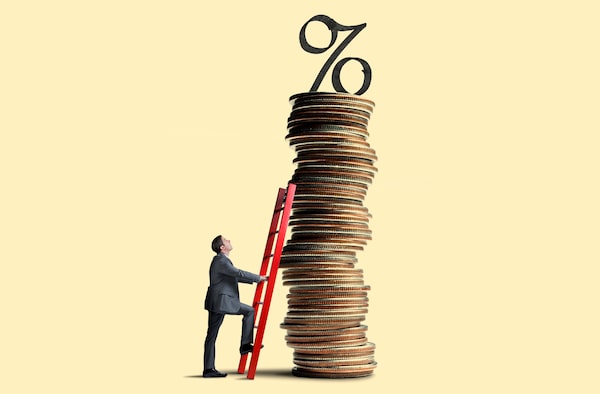
A return of 5 to 6 per cent on a typical locked-in GIC today would be taxed at a rate of roughly 50 per cent for higher-income Canadians.DNY59/iStockPhoto / Getty Images
Sign up for the Globe Advisor weekly newsletter for professional financial advisors on our sign-up page. Get exclusive investment industry news and insights, the week’s top headlines, and what you and your clients need to know. For more from Globe Advisor, visit our homepage.
Rising interest rates have made guaranteed investment certificates (GICs) a hugely popular investment over the past year, but there are drawbacks investors need to consider before locking in.
Advisors say GICs make sense for short-term financial needs and investors who need peace of mind, but warn profits are taxed at a higher rate than capital gains or dividend income.
“GICs are the original do-it-yourself investment. They’re very clear and straightforward. The biggest choice you have to make is where to buy them,” says Jennifer Tozser, senior wealth advisor and portfolio manager with Tozser Wealth Management at National Bank Financial Wealth Management in Calgary.
GICs up to $100,000 are also backstopped by the Canada Deposit Insurance Corp., “so there’s a lot of protection when you’re buying a GIC,” she adds. “You feel like you’re really in charge of the situation.”
GICs 101: What is a guaranteed investment certificate?
However, interest income earned from GICs in non-registered accounts is taxed at an investor’s marginal rate, which is higher than the tax rate for capital gains and dividends from equities and bonds. It’s why advisors often suggest GICs for near-term investment needs, such as buying a car or home, and investing in bonds and equities for the long term.
“GICs can form part of a portfolio, but they should never be the portfolio,” Ms. Tozser says.
She notes that a return of 5 to 6 per cent on a typical locked-in GIC today would be taxed at a rate of roughly 50 per cent for higher-income Canadians.
“When it comes to tax efficiency of investments, the gold standard is capital gains in Canada,” for which only 50 per cent of the profit is taxed, Ms. Tozser adds.
“If you get 5 per cent in interest income from a GIC and 5 per cent in capital gain from a stock, you want the 5 per cent in capital gains.”
And while GIC rates are at some of the highest levels they’ve been in years, Ms. Tozser says it’s unlikely they will remain this high for the long term, especially if central banks start to cut interest rates next year as some market watchers predict.
Stocks and bonds are riskier, but Ms. Tozser says they’re more tax-efficient and can potentially generate higher returns for longer.
“There is no stock market return without uncertainty, and that will never go away,” she says.
‘Every good trade comes to an end’
Konstantin Boehmer, senior vice-president, portfolio manager and co-lead of fixed income at Mackenzie Investments in Toronto, says GICs have been a great investment since interest rates started rising last year, “but every good trade comes to an end.”
He believes investors should now consider short-term bonds that offer yields north of 5 per cent.
While the rates are roughly the same as GICs or high-interest savings accounts (HISAs), he says bonds are more flexible because they’re not locked in. They also provide “potential for upside beyond their current-day yield,” he adds, pointing to predictions that central banks will soon stop hiking interest rates if they haven’t already.
Rob Carrick: Check your big bank savings account - you could be making ‘0.000 per cent’ interest
“Historically, under these conditions, bonds have flourished post the final rate hike, offering upside beyond the locked-in yield of risk-free alternatives,” he says.
“GICs and HISAs have had their blue skies moment in the sun, but with potential storm clouds on the horizon, diversifying with short-term bonds could be the key to weathering future uncertainties.”
And while bonds were hammered last year, “that’s rear-view mirror stuff,” Mr. Boehmer says.
“Bonds have been through boot camp and have built their strength,” he adds. “Now they have muscles, are super agile and can defend themselves – and portfolios.”
GICs could work in some registered accounts
Matt Trotta, vice president, tax, retirement and estate planning at CI Global Asset Management in Calgary, says GICs might make more sense in certain registered accounts such as a tax-free savings account (TFSA) or the new first home savings account (FHSA) so long as the contributions are below the limits.
“If somebody’s looking at buying a house within the next few years, GICs can be a safe and predictable way to get some growth,” he says.
In other cases, he says investors might prefer GICs to “cover the bumps” when markets are volatile and they have shorter-term cash needs.
Mr. Trotta adds GICs, especially at today’s higher rates, can also provide investors peace of mind. That could be for a senior on a fixed income, someone saving for a near-term purchase, or anyone who loses sleep watching the markets go up and down.
“It comes down to how much volatility can you accept? For some investors, you have to factor in their mental health and well-being,” he says. “For advisors, it’s about knowing your client and what they can handle.”
For more from Globe Advisor, visit our homepage.